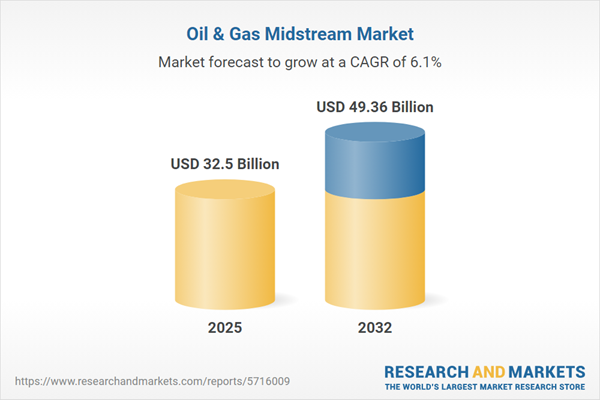Speak directly to the analyst to clarify any post sales queries you may have.
The oil and gas midstream market is undergoing substantial transformation as companies adapt to shifting regulations, integrate digital technologies, and respond to evolving energy mandates. Senior executives are adjusting strategies to ensure resilience, capture new efficiencies, and safeguard competitive standing.
Market Snapshot: Oil & Gas Midstream Market Size, Growth, and Outlook
The oil and gas midstream market is currently valued at USD 30.65 billion, with forecast year-over-year growth to USD 32.50 billion and longer-term expansion projected to reach USD 49.36 billion by 2032. This sector reflects a 6.13% compound annual growth rate, driven by sustained investments in pipeline networks, increasing demand for advanced storage, and a focus on modernizing existing assets. Digitalization is reshaping asset management and streamlining operations, while heightened competition and continuous regulatory updates are prompting leadership to optimize capital allocation and reevaluate logistics frameworks amidst ongoing mergers and changing energy policies.
Scope & Segmentation: Strategic Structure of the Oil & Gas Midstream Sector
This comprehensive report delivers detailed segment-level insights to support investment evaluation and operational refinement for senior decision-makers in the oil and gas midstream market. Coverage is structured to facilitate benchmarking and identification of opportunities for technology adoption across major market areas.
- Product Types: Heavy, medium, and light crude oil; conventional and unconventional natural gas; natural gas liquids such as butane, ethane, propane; refined products including diesel, gasoline, and jet fuel. This segmentation allows organizations to fine-tune logistics processes and maximize resource utilization within complex supply environments.
- Service Offerings: Compression for onshore and offshore projects; advanced gas processing; liquefaction; fractionation; aboveground and underground storage. These services contribute to optimized system reliability and elevate operational performance.
- Transportation Modes: Barge transport, pipelines (onshore and offshore), LNG carriers, and multimodal logistics utilizing rail, truck, and flatbed. This comprehensive approach addresses local regulatory hurdles and diverse infrastructure needs across geographies.
- End User Categories: Retail distributors, industrial users, petrochemical centers, power utilities, and residential consumers. Understanding varying demand patterns across these segments supports proactive supply and capital planning.
- Regions & Countries: Americas, Europe, Middle East, Africa, and Asia-Pacific, analyzed with attention to regulatory trends, geopolitical influences, and country-specific risks. This regional perspective informs targeted strategy development and market benchmarking.
- Leading Companies Assessed: Enbridge Inc., Kinder Morgan, Enterprise Products Partners, Energy Transfer, TC Energy, The Williams Companies, Plains All American Pipeline, ONEOK, MPLX, and Targa Resources. Comparative company analysis supports informed partner selection and market entry evaluation.
Key Takeaways for Senior Decision-Makers
- Analytics and automation are driving digitalization efforts, providing enhanced predictive capabilities for asset management and improving real-time oversight across logistics networks.
- Leadership teams are implementing agile procurement and dynamic sourcing models to better address market volatility and shifts in compliance standards.
- Modernization initiatives are enabling organizations to align with emerging regulations while progressing towards broader energy transition objectives.
- Diversified transport and logistics strategies minimize operational risk amid diverse environmental and regulatory landscapes.
- Risk management practices and operational models now reflect international best practices and evolving sectoral requirements, supporting consistent compliance and business continuity.
Tariff Impact: Cost Pressures and Supply Chain Shifts
Tariffs imposed on essential pipeline components in the United States have led to increased supply chain costs and extended project timelines. In response, industry players are adopting a greater emphasis on local sourcing and enhancing project management agility to counterbalance these challenges. Ongoing and proactive monitoring of global trade policies is vital for maintaining delivery reliability and operational continuity in a changing marketplace.
Methodology & Data Sources
The report integrates comprehensive sector data, regulatory updates, and expert insights through structured scenario modeling and multi-stage analysis. This methodology supports senior executives in developing risk mitigation and capital deployment strategies that align with the oil and gas midstream market’s demands.
Why This Report Matters
- Offers actionable intelligence to guide digital investment and compliance management within a dynamic regulatory landscape.
- Equips leaders to drive cost efficiency, streamline operations, and enhance comprehensive risk oversight throughout supply chains.
- Fosters business resilience and encourages strategic forward planning during periods of significant sector transformation.
Conclusion
This report enables senior decision-makers to clarify market direction, refine investment approaches, and elevate risk controls as they lead their organizations through the continuing transformation of the oil and gas midstream sector.
Additional Product Information:
- Purchase of this report includes 1 year online access with quarterly updates.
- This report can be updated on request. Please contact our Customer Experience team using the Ask a Question widget on our website.
Table of Contents
3. Executive Summary
4. Market Overview
7. Cumulative Impact of Artificial Intelligence 2025
Companies Mentioned
The companies profiled in this Oil & Gas Midstream market report include:- Enbridge Inc.
- Kinder Morgan, Inc.
- Enterprise Products Partners L.P.
- Energy Transfer LP
- TC Energy Corporation
- The Williams Companies, Inc.
- Plains All American Pipeline, L.P.
- ONEOK, Inc.
- MPLX LP
- Targa Resources Corp.
Table Information
| Report Attribute | Details |
|---|---|
| No. of Pages | 187 |
| Published | November 2025 |
| Forecast Period | 2025 - 2032 |
| Estimated Market Value ( USD | $ 32.5 Billion |
| Forecasted Market Value ( USD | $ 49.36 Billion |
| Compound Annual Growth Rate | 6.1% |
| Regions Covered | Global |
| No. of Companies Mentioned | 11 |









